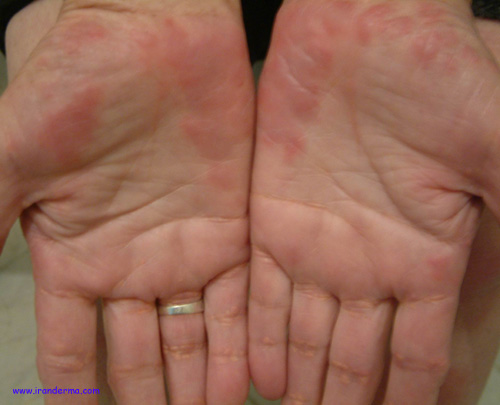IRANDERMA |
|
Quiz: June 2004 |
A 51 year-old-woman presented with acute onset of painful lesions on her hands and legs. On physical examinations, she was ill and febrile. Plum-colored plaques were seen on her palms and legs . Neutrophilia, elevated ESR, hematuria, hypertiglyceridemia and a raised IgM level were noticeable findings in laboratory examinations. What is your diagnosis?

Diagnosis: Sweet's syndrome + Xanthoma palmaris
Comment by Dr.M. Mehravaran, Szeged/Hungary:
In 1964, R.D. Sweet described a syndrome that he called an "acute febrile neutrophilic dermatosis" that was characterized by 4 primary features:
1. a cutaneous eruption consisting of tender erythematous papulues and plaques.
2. histopathologic features of dermal, non-vasculitic, neutrophilic inflammation
3. fever and
4. peripheral neutrophilia.
Most studies have indicated a striking female predominance, with a female-to-male ration 4:1. The average age at onset ranges from 30 to 60 years.
Subsequently, other extracutaneous manifestations including joint manifestations (severe myalgias, artheralgias, and migratory arthritis) and ocular involvement (conjunctivitis, iridocyclitis). It has been established that a minority of patients with sweet syndrome may have or will develop a concurrent MALIGNANCY.
Malignancy occurs in approximately 20% of patients with sweet's syndrome. The vast majority of the malignancies are hematopoitic and of these acute myelogenous leukemia (AML) is the most common.
Sweet's syndrome as a paraneoplastic condition is most commonly associated with leukemia, particularly AML, although other leukemias or lymphoma have been reported. Solid tumors, which are less commonly associated (15% of all), include adenocarcinoma, emberyonal testicular carcinoma, ovarian carcinoma, and adenocarcinoma of the prostate and rectum.
Is also important to mentioned here that in this patient on palmar area there are many XANTHOMAS. Plane xanthomas are the most common paraneoplastic xanthomas, and the cancer association is usually with multiple myeloma, Xanthomas haves also been associated with other hematopoietics malignancies, including lymphocytic, myelocytic and myelomonocytic leukemia and CTCL.
Differential Dg
Inflammatory Dermatoses: Erythema Multiforme, Urticaria, Urticarial vasculitis, Leukocytoclasic vasculitis, panniculitis including erythema nodosum, pyodema gangeranosum and halogenoderma.
Infectious: Pyoderma, bacterial sepsis, deep fungal infection, atypical acid-facst bacterial infection, leishmaniasis.
Neoplastic: Lymphoma cutis, leukemia cutis, cutaneous metastasis.
ايران درما |
